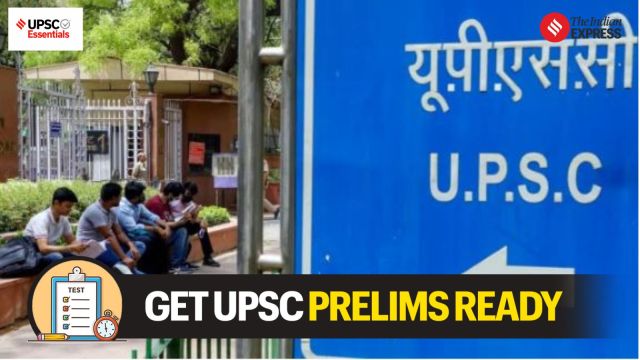The UPSC CSAT examination is just a few days away, and with the admit cards now released, many aspirants are turning their attention to exam hall strategy and how best to attempt the paper. Over the past few years, CSAT — once considered a qualifying formality — has evolved into a silent eliminator, filtering out candidates regardless of their General Studies performance.
With just days remaining before the UPSC Civil Services Preliminary Examination 2025, aspirants across the country are intensifying their preparations. While General Studies continues to command the bulk of attention, the Civil Services Aptitude Test (CSAT) presents its own set of challenges — and risks.
Recognising this shift, UPSC Essentials launched the ‘UPSC CSAT Simplified’ series earlier this year. The aim: to break down key concepts from the CSAT paper and offer practice questions to help candidates track their progress.
Today, we pause from the usual syllabus-driven discussions to address an often overlooked yet vital aspect of preparation: exam hall strategy.
In this article, Manas Srivastava speaks with CSAT expert Mudit Gupta, who shares practical strategies to help candidates secure the crucial one-third qualifying marks in CSAT. His insights focus not just on improving accuracy, but also on avoiding common time traps.
Whether you’re a first-time candidate or a returning aspirant, a methodical approach to the CSAT paper could make all the difference on May 25 — the day of prelims exams.
Story continues below this ad
About our Expert: Mudit Gupta has been a mentor and faculty for the UPSC Civil Services exam for 8 years with expertise in CSAT, Polity, International Relations, and Current Affairs. He is known to break complex concepts into simpler ones that allow UPSC aspirants to develop a grip over the subject matter.
#1 LEAVE BIASES OUT OF THE EXAM HALL
There is a widespread misconception that CSAT is all about tough mathematics questions, and students from a humanities background cannot solve them. Experience tells me that CSAT is an unpredictable turf ground. There have been instances when English reading comprehension was more difficult than quantitative aptitude. So, there is no generalised fixed trend regarding the difficulty level of the CSAT exam. It varies every year.
Moreover, many aspirants from premier engineering colleges of the country have failed to score the minimum 1/3 marks in CSAT on multiple occasions. So, the stream of the candidate is immaterial while solving the CSAT paper.
It’s a misconception that students from a science background have an edge over others in the CSAT paper.
#2 DON’T SEARCH FOR QUESTIONS FROM A SPECIFIC TOPIC
Each one of us has certain strong and weak areas in a subject. However, to clear the exam, we cannot just attempt the questions only from our strong areas. The weightage of every chapter is limited, and to be able to clear the cut-off comfortably, we need to attempt the questions from across the spectrum. Sometimes, aspirants move ahead with the strategy of finding the questions from a specific chapter or a specific subject in the paper first and then attempting questions from other areas. This is a time-consuming and inefficient strategy.
Story continues below this ad
To find questions from a specific chapter or subject out of the mixed bag of 80 questions is time-consuming and will eat up the time from the limited 120 minutes that we have to solve the 80 questions. It is always advisable to solve the questions in the order in which they appear in the question paper.
#3 SKIPPING > NEGATIVE MARKING
Before pouncing on the prey, a lion always takes a step back. That stepping back is not a weakness, but rather the strength of a lion. Following the similar analogy, whenever you encounter a question that you think is partially solvable or you’re not very confident about its answer, it is always better to skip that question.
Every negative mark will erode your positive marks and thus pull you downwards. Skipping a question will fetch you 0 marks, but wrongly attempting a question will take away your 0.83 marks
#4 NUMBER OF QUESTIONS TO BE ATTEMPTED
Just before the exam, this is one question that I am asked the most. The number of questions to be attempted depends solely on your accuracy in the exam hall. It is a given that you don’t need to attempt all 80 questions. Some aspirants have a preset number in mind regarding the number of questions to be attempted. In the quest to achieve that number, they tend to over-attempt, ultimately leading to negative marking. Never enter the exam hall with a preset number. Depending on the difficulty level of the overall paper and the difficulty level of individual subjects of quantitative aptitude, logical reasoning, and English reading comprehension, you should decide how much to attempt in the overall paper and how much to attempt from each subject.
#5 TIME FOR EACH QUESTION
Ideally, to attempt 80 questions in 120 minutes, you need 1.5 minutes per question. However, the requirement of CSAT is such that we don’t need to attempt all 80 questions to be on the other side of the cut-off. While attempting the CSAT paper, different questions will require different amounts of time depending on the length of the paragraph or the length of the calculation involved. Hence, we cannot assign a uniform amount of time to every question.
Story continues below this ad
However, a few basic parameters to be kept in mind while solving the questions would be: if you think that a question is a bit on the lengthier side, but you’re confident of getting close to the right answer, you should attempt it.
Moreover, avoid the ego battles at all costs. If there’s a tough question from your strong area, and it is likely that you will not get the answer, in such cases, you should not be stubborn and, rather, move ahead to capture the low-hanging fruit.
BTW:
Haven’t tried our UPSC CSAT Practice Sets yet? Check out CSAT Practice Set 1 (click here), Practice Set 2 (click here), Practice Set 3 (click here), Practice Set 4 (click here),Practice Set 5 (click here) , Practice Set 6 (click here) , Practice Set 7 (click here) , Practice Set 8 (click here) ,Practice Set 9(click here),Practice Set 10(click here)., Practice Set 11(click here), Practice Set 12 (click here). and Practice Set 13 (click here).



































